Basic type of resume #1: chronological
This is by far the most commonly used resume format. It begins with your most recent work experience and goes backward. Technically this is reverse chronological order. Hiring managers like this resume because it clearly paints a picture of your work history, career growth, and accomplishments. If you’ve worked in the same company for years and “climbed the ladder” so to say, you would list each job title you held within the company and list them in reverse chronological order.
When to use them: This type of resume is most effective for people who have remained in the same industry, company, or career function for some time and have enough experience to fill up a page. This is also best for individuals who have no employment gaps and have consistent employment.

Basic type of resume #2: functional
Functional resumes may be useful if you have experience across multiple industries or if you don’t have a great deal of experience in the industries you are applying for. Functional resumes don’t follow a chronological order, instead, they go in order of the most relevant experience to the least relevant. For example, a functional resume can list a job you worked at three years ago first, if it is the most relevant position to the job you’re applying for. These resumes also do not necessarily need to be uniform. In a chronological resume, you may have five bullets to describe the functions of each position you worked for. However, functional resumes typically allow you to provide more information about the positions that most match the position you’re applying for. On a functional resume, it is not simply listing your recent jobs and corresponding tasks in reverse chronological order, you’d select only the most relevant responsibilities from each of your past roles and combine them to paint a bigger picture of your skills and abilities. As a caveat, this is not an ideal resume. It’s not very common and therefore not as natural to read. If you are deciding between a functional resume or a combination resume, we recommend that latter.
When to use them: This resume format is best for individuals with employment gaps, no recent experience, a career change, and little traditional work experience.
Basic type of resume #3: combination
A combination resume is the best of both worlds. It has elements of a chronological resume and functional resume. It is a way for you to highlight your skills, qualifications, and accomplishments while still showing your work experience in the traditional chronological manner. These kinds of resumes help you direct employers’ attention to the skills you’d like to highlight, while still providing a thorough list of your previous work experiences. This way, you have discussed your achievements at a high level while also expressing your ability to support the company you are applying for. You can also include a specific accomplishment if one comes to mind. It is important to quantify your experience everywhere possible. By now, you may have heard that hiring managers don’t spend too much time on a resume before deciding if it’s rejected or worth a further read. Therefore, it’s important to show how you are going to support the company’s goals clearly and quickly.
When to use them: Similar to functional resumes, this is best for individuals with employment gaps, no recent experience, a career change, and little traditional work experience, significant work experience in different roles.

Basic type of resume #4: design
Design or infographic resumes are graphically enhanced and use visual elements to highlight skills. They may use a graph or chart to demonstrate proficiency within a specific skill rather than simply stating it. Hiring managers read plenty of resumes throughout the day. Creating a resume that looks different and easy on the eye will set you apart from other candidates. Remember, do not use this when applying to a company using an ATS.
When to use them: It’s always appropriate to have a design resume on file. They are best to use when handing a printed version to someone you meet and when you are sending your resume to someone directly via email. These resumes are especially effective when applying for jobs in a creative field, such as graphic design, social media marketing, or content creation. Design resumes should not be used when applying online through portals, in other words, through an applicant tracking system.

Remember, there are more types of resumes than the 4 we just reviewed. Resumes that follow chronological order are the norm and are best to use. However, we understand that jobseekers come from all walks of life and there are times when a different format will be better. It’s good to know your options.
If you are seeking help with your resume and guidance on how to land your next job, schedule a free consultation with us.
Subscribe to our blog
Don’t miss out on the latest college admissions trends, updates, and tips!



